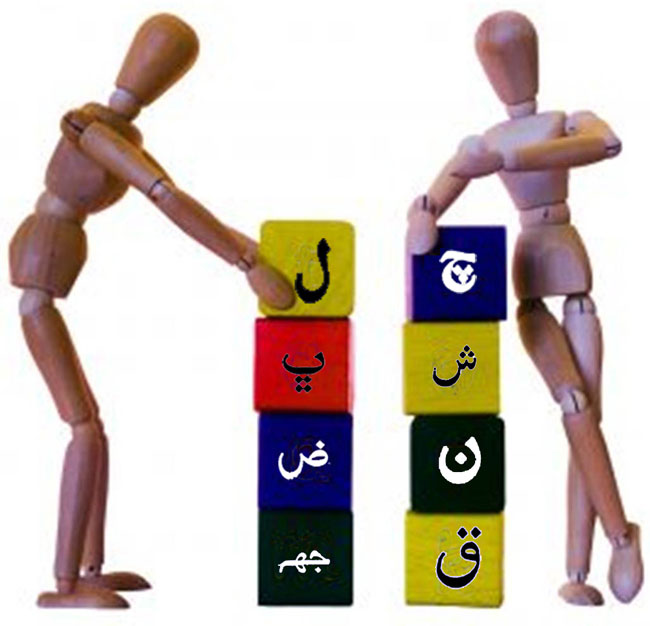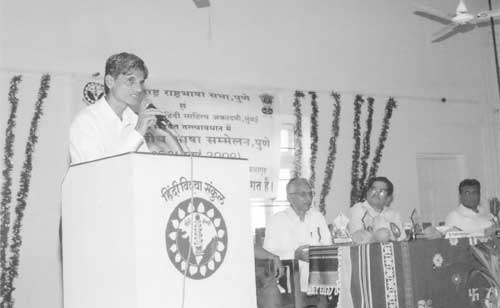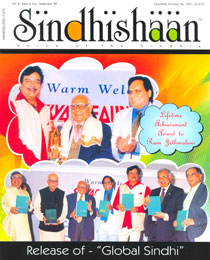ORIGIN OF SINDHI LANGUAGE
by Dr. Baldev B. Matlani

It is but natural that we would like to go back some 5000 years and connect ourselves to the great Indus civilization of Mohen-Jo- Daro, because even within our own precincts, we find the symbols of highly developed and civilized society, whose people used to cover their bodies with the finest cotton cloth in the times when the rest of the world satisfied themselves by using leaves and animal skin. The people of Sindh in those times were experts at archaeology, town planning, handicrafts, sculpture and ornaments etc. Their language had crossed the boundary of communication of thoughts and the seals discovered from the ruins un-equivocally prove that the language was also written at that time. Unfortunately, we have not been able to decipher that script but the fault lies with us and not the people of those times.
Regarding the origin of Sindhi language, after some works of European scholars, the first ever Indian research work published on it has been a book by Bherumal Mehrchand Advani, titled 'Sindhi Boli a Ji Tarikh', in 1941. It had relied on the opinion of many linguistic experts and came to the conclusion that Sindhi has been derived from Vedic Sanskrit, which metamorphosed first into classical Sanskrit, then to Pali, Prakrit, Apabhramsa and present Sindhi has been the direct daughter of Vrachad Apabhramsa.
Later on, a prominent linguistic expert from Sindh, Dr. Nabi Bux Baloch rejected the theory propounded by Bherumal Advani. He was of the opinion that Sindhi belonged to the family of semetic languages which was contemporary of the language of erstwhile Sumerian civilization and locally it related to Dravadian language.
In 2005, I had organized an International Seminar on this subject at University of Mumbai, where a world renowned scholar of Sindhi language, Siraj-ul-Haq Memon, who hails from Sindh presented his paper. He was a lone voice of dissent of the abovesaid theory of Dr. Nabi Bux Baloch. During the seminar, he said:
“During the late fifties and early sixties, when a person of high calibre, Dr. Nabi Bux Baloch presented his experimental and thoughtless theory that Sindhi belong to the family of Semitic language, I was utterly flabbergasted and wondered as to how could such a great scholar come out with a theory which was not only baseless but un-necessary too, and which lacked the corroboration of linguistic or anthropological theories.”
 Mr. Siraj-ul-Haq Memon had published a book 'Sindhi Boli' in 1964 and opined that Sindhi language had actually taken birth within the geographical confines of Sindh itself, which leads us to believe that the language engraved on the seals recovered from Mohen Jo Daro was Proto-Sindhi. Though, he also admitted that Sindhi was some way or another related to Sanskrit, yet Sindhi was even older. He meant to say that Sanskrit was a daughter of Sindhi and not the other way round. He agreed that there were many sceptics even in Sindh, who couldn't agree with his theory. He was termed as a crazy lover of Sindhi language and suffering from superiority complex. His critics included Dr. Nabi Bux Baloch, Dr. Ali Nawaz Jatoi and many more belonging to the right wing of the political spectrum. The shrill agitation of these rightists resulted in Mr. Siraj Ul Haq Memon's dismissal from the revenue services of Pakistan. He was an income Tax Officer at that time. Mohd. Ibrahim Joyo, who had penned the 'Preface' of Siraj ul Haq Memon's book 'Sindhi Boli' had said that Sanskrit, Sindhi and other Indo-Aryan languages had all come from a single source which could be termed as Proto-Sindhi or Proto-Indic.
Mr. Siraj-ul-Haq Memon had published a book 'Sindhi Boli' in 1964 and opined that Sindhi language had actually taken birth within the geographical confines of Sindh itself, which leads us to believe that the language engraved on the seals recovered from Mohen Jo Daro was Proto-Sindhi. Though, he also admitted that Sindhi was some way or another related to Sanskrit, yet Sindhi was even older. He meant to say that Sanskrit was a daughter of Sindhi and not the other way round. He agreed that there were many sceptics even in Sindh, who couldn't agree with his theory. He was termed as a crazy lover of Sindhi language and suffering from superiority complex. His critics included Dr. Nabi Bux Baloch, Dr. Ali Nawaz Jatoi and many more belonging to the right wing of the political spectrum. The shrill agitation of these rightists resulted in Mr. Siraj Ul Haq Memon's dismissal from the revenue services of Pakistan. He was an income Tax Officer at that time. Mohd. Ibrahim Joyo, who had penned the 'Preface' of Siraj ul Haq Memon's book 'Sindhi Boli' had said that Sanskrit, Sindhi and other Indo-Aryan languages had all come from a single source which could be termed as Proto-Sindhi or Proto-Indic.
In 1974, Dr. Gulam Ali Allana published a book 'The Origin of Sindhi Language', in which he said that before the advent of Aryans into the subcontinent, the locals used to converse in Dravidian languages. He further said that, the language of the people of Mohen Jo Daro was Sindhi, which had accepted the influence of Dardi and some languages of the areas bordering Iran. Later on, it was influenced by Sanskrit and Pali too; though Sindhi retained its grammatical structure, then too it become rich with the addition of many words from Sanskrit or Pali.
Dr. Ernest Trumpp, in his article 'The Relationship of Sindhi to the Sanskrit & Prakrit' has said:
“If we compare the Sindhi now with its sister-tongues, we must assign to it, in a grammatical point of view, the first place among them. It is much more closely related to the old Prakrit, than the Marathi, Hindi, Punjabi and Bengali of our base, and it has preserved an exuberance of grammatical forms, for which all its sisters may well envy it.”
Though, the question of the origin of Sindhi language has been an important one, then too the theories propounded by various linguistic experts have been at cross purposes. These theories have muddied the whole issue and have been unable to come to a single conclusion.
I, myself agree with the theory of Bherumal Mehrchand Advani, who had said that the Sanskrit had been a mother of most of the world languages including Sindhi.
(Paper presented at Sarva Bhartiya Bhasha Sammelan, organized by Maharashtra Rashtra Bhasha Sabha & Maharashtra State Hindi Sahitya Academy, at Pune, on July 25-26, 2009)



